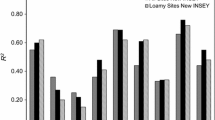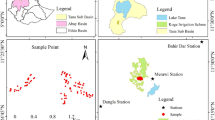Abstract
Crop coefficient methodologies are widely used to estimate actual crop evapotranspiration (ETc) for determining irrigation scheduling. Generalized crop coefficient curves presented in the literature are limited to providing estimates of ETc for “optimum” crop condition within a field, which often need to be modified for local conditions and cultural practices, as well as adjusted for the variations from normal crop and weather conditions that might occur during a given growing season. Consequently, the uncertainties associated with generalized crop coefficients can result in ETc estimates that are significantly different from actual ETc, which could ultimately contribute to poor irrigation water management. Some important crop properties such as percent cover and leaf area index have been modeled with various vegetation indices (VIs), providing a means to quantify real-time crop variations from remotely-sensed VI observations. Limited research has also shown that VIs can be used to estimate the basal crop coefficient (K cb) for several crops, including corn and cotton. The objective of this research was to develop a model for estimating K cb values from observations of the normalized difference vegetation index (NDVI) for spring wheat. The K cb data were derived from back-calculations of the FAO-56 dual crop coefficient procedures using field data obtained during two wheat experiments conducted during 1993–1994 and 1995–1996 in Maricopa, Arizona. The performance of the K cb model for estimating ETc was evaluated using data from a third wheat experiment in 1996–1997, also in Maricopa, Arizona. The K cb was modeled as a function of a normalized quantity for NDVI, using a third-order polynomial regression relationship (r 2=0.90, n=232). The estimated seasonal ETc for the 1996–1997 season agreed to within −33 mm (−5%) to 18 mm (3%) of measured ETc. However, the mean absolute percent difference between the estimated and measured daily ETc varied from 9% to 10%, which was similar to the 10% variation for K cb that was unexplained by NDVI. The preliminary evaluation suggests that remotely-sensed NDVI observations could provide real-time K cb estimates for determining the actual wheat ETc during the growing season.








Similar content being viewed by others
References
Allen RG, Pereira LS, Raes D, Smith M (1998) Crop evapotranspiration. FAO irrigation and drainage paper 56. Food and Agricultural Organization of the United Nations, Rome, pp 300
Bausch WC (1995) Remote sensing of crop coefficients for improving the irrigation scheduling of corn. Agric Water Manage 27:55–68
Bausch WC, Neale CMU (1987) Crop coefficients derived from reflected canopy radiation: A concept. Trans ASAE 30(3):703–709
Bausch WC, Neale CMU (1989) Spectral inputs improve corn crop coefficients and irrigation scheduling. Trans ASAE 32(6):1901–1908
Brown PW (1989) Accessing the Arizona Meteorological Network (AZMET) by computer. (Ext Rep 8733) University of Arizona, Tucson, AZ, pp 26
Doorenbos J, Pruitt WO (1977) Crop water requirements. FAO irrigation and drainage paper 24. Food and Agricultural Organization of the United Nations, Rome, pp 144
Erie LJ, French OF, Bucks DA, Harris K (1982) Consumptive use of water by major crops in the southwestern United States. Cons Res Rep no 29, USDA, Washington, DC, pp 40
Fox FA Jr, Scherer T, Slack DC, Clark LJ (1992) Arizona irrigation scheduling user’s manual. Cooperative extension, agriculture and biological engineering, University of Arizona, Tucson, AZ, pp 36
Heilman JL, Heilman WE, Moore DG (1982) Evaluating the crop coefficient using spectral reflectance. Agron J 74:967–971
Huete AR (1988) A soil adjusted vegetation index (SAVI). Remote Sens Environ 25:295–309
Hunsaker DJ, Hendrey GR, Kimball BA, Lewin KF, Mauney JR, Nagy J (1994) Cotton evapotranspiration under field conditions with CO2 enrichment and variable soil moisture regimes. Agric Meteorol 70:247–258
Hunsaker DJ, Kimball BA, Pinter PJ Jr, LaMorte RL, Wall GW (1996) Carbon dioxide enrichment and irrigation effects on wheat evapotranspiration and water use efficiency. Trans ASAE 39(4):1345–1355
Hunsaker DJ, Kimball BA, Pinter PJ Jr, Wall GW, LaMorte RL, Adamsen FJ, Leavitt SW, Thompson TL, Matthias AD, Brooks TJ (2000) CO2 enrichment and soil nitrogen effects on wheat evapotranspiration and water use efficiency. Agric Meteorol 104:85–105
Hunsaker DJ, Pinter PJ Jr, Barnes EM, Kimball BA (2003) Estimating cotton evapotranspiration crop coefficients with a multispectral vegetation index. Irrigation Sci 22:95–104
Jackson RD, Huete AR (1992) Interpreting vegetation indices. Prev Vet Med 11:185–200
Jayanthi H, Neale CMU, Wright JL (2001) Seasonal evapotranspiration estimation using canopy reflectance: a case study involving pink beans. In: Owe M, Brubaker K, Ritchie J, Rango A (eds) Proceedings of the International Symposium on Remote Sensing and Hydrology 2000. IAHS Press, Wallington, Oxfordshire, UK, pp 302–305
Jensen ME, Burman RD, Allen RG (1990) Evapotranspiration and irrigation water requirements. Manuals and reports on engineering practices no. 70. ASCE, New York
Kimball BA, Pinter PJ Jr, Garcia RL, LaMorte RL, Wall GW, Hunsaker DJ, Wechsung G, Wechsung F, Kartschall T (1995) Productivity and water use of wheat under free-air CO2 enrichment. Global Change Biol 1:429–442
Kimball BA, LaMorte RL, Pinter PJ Jr, Wall GW, Hunsaker DJ, Adamsen FJ, Leavitt SW, Thompson TL, Matthias AD, Brooks TJ (1999) Free-air CO2 enrichment and soil nitrogen effects on energy balance and evapotranspiration of wheat. Water Resour Res 35(4):1179–1190
Kustas WP, Zhan X, Jackson TJ (1999) Mapping surface energy flux partitioning at large scales with optical and microwave remote sensing data from Washita ‘92. Water Resour Res 35(1):265–277
Legate DR, McCabe GJ Jr (1999) Evaluating the “goodness-of-fit” measures in hydrologic and hydroclimatic model validation. Water Resour Res 35(1):233–241
Moran MS, Mass SJ, Pinter PJ Jr (1995) Combining remote sensing and modeling for estimating surface evaporation and biomass production. Remote Sensing Rev 12:335–353
Neale CMU, Ahmed RH, Moran MS, Pinter PJ Jr, Qi J, Clarke TR (1996) Estimating seasonal otton evapotranspiration using canopy reflectance. In: Camp CR, Sadler EJ, Yoder RE (eds) Evapotranspiration and irrigation scheduling, Proceedings of the international conference, 3–6 Nov 1996, San Antonio, Texas. ASAE, St Joseph, MI, pp 173–181
Pinter PJ Jr, Kimball BA, Mauney JR, Hendrey GR, Lewin KF, Nagy J (1994) Effects of free-air carbon dioxide enrichment on PAR absorption and conversion efficiency by cotton. Agric Meteorol 70:209–230
Pinter PJ Jr, Kimball BA, Garcia RL, Wall GW, Hunsaker DJ, LaMorte RL (1996) Free-Air CO2 enrichment: responses of cotton and wheat crops. In: Koch GW, Mooney HA (eds) Terrestrial ecosystems responses to elevated carbon dioxide. Academic, Orlando, FL, pp 215–249
Pinter PJ Jr, Kimball BA, LaMorte RL, Wall GW, Hunsaker DJ, Adamsen FJ, Frumau KFA, Vugts HF, Hendrey GR, Lewin KF, Nagy J, Johnson HB, Thompson TL, Matthias AD, Brooks TJ (2000) Free-air CO2 enrichment (FACE): blower effects on wheat canopy microclimate and plant development. Agric Meteorol 103(4):319–332
Wall GW, Kimball BA (1993) Biological databases derived from free air carbon dioxide enrichment experiments. In: Schulze ED, Mooney HA (eds) Design and execution of experiments on CO2enrichment, Ecosystems report 6. Environmental Research Programme, Commission of the European Communities, Brussels, Belgium, pp 329–351
Wechsung G, Wechsung F, Wall GW, Adamsen FJ, Kimball BA, Garcia RL, Pinter PJ Jr, Kartschall T (1995) Biomass and growth rate of spring wheat root system grown in free-air CO2 enrichment (FACE) and ample soil moisture. J Biogeogr 22:623–634
Wechsung G, Wall GW, Wechsung F, Kimball BA, Pinter PJ Jr, Adamsen FJ, Hunsaker DJ, LaMorte RL (1998) Effects of free-air CO2 enrichment (FACE) and soil water and soil nitrogen on the root growth of spring wheat. In: US Water Conservation Laboratory Annual Report, 1998. USDA, Agric Res Ser, Phoenix, AZ, pp 94–97
Author information
Authors and Affiliations
Corresponding author
Additional information
Communicated by E. Christen
Rights and permissions
About this article
Cite this article
Hunsaker, D.J., Pinter, P.J. & Kimball, B.A. Wheat basal crop coefficients determined by normalized difference vegetation index. Irrig Sci 24, 1–14 (2005). https://doi.org/10.1007/s00271-005-0001-0
Received:
Accepted:
Published:
Issue Date:
DOI: https://doi.org/10.1007/s00271-005-0001-0




